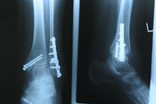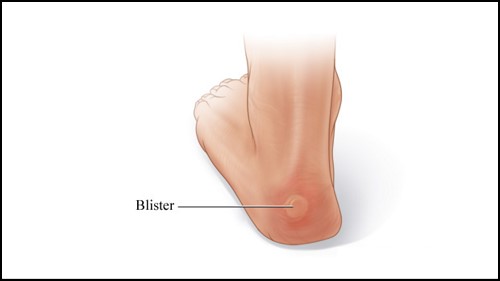Items filtered by date: October 2016
Surgery expected for Ben Simmons
 Ben Simmons of the Philadelphia 76ers is expected to undergo surgery on his broken foot. He is expected to be out for three months, which would push his NBA debut into 2017. Simmons fractured his fifth metatarsal in his right foot during a team practice. There has been speculation that the injury may be a result of Simmons’ recent weight gain, since he gained over 30 pounds of muscle during the summer.
Ben Simmons of the Philadelphia 76ers is expected to undergo surgery on his broken foot. He is expected to be out for three months, which would push his NBA debut into 2017. Simmons fractured his fifth metatarsal in his right foot during a team practice. There has been speculation that the injury may be a result of Simmons’ recent weight gain, since he gained over 30 pounds of muscle during the summer.
Foot surgery is sometimes necessary to fix a foot ailment. To learn more, contact Dr. Joshua David Scoll of Pennsylvania. Our doctor can provide the care you need to keep you pain free and on your feet.
When Is Surgery Necessary?
Foot and ankle surgery is generally reserved for cases in which less invasive, conservative procedures have failed to help with the problem. Some of the cases in which surgery may be necessary are:
- Removing foot deformities like bone spurs and bunions
- Severe arthritis that has caused bone issues
- Cosmetic reconstruction
What Types of Surgery Are There?
The type of surgery you receive will depend on the nature of the problem you have. Some of the possible surgeries include:
- Bunionectomy for painful bunions
- Surgical fusion for realignment of bones
- Neuropathy decompression surgery to treat nerve damage
Benefits of Surgery
Although surgery is usually a last resort, it can provide more complete pain relief compared to non-surgical methods and may allow you to finally resume full activity.
Surgical techniques have also become increasingly sophisticated. Techniques like endoscopic surgery allow for smaller incisions and faster recovery times.
If you have any questions please contact our offices located in Philadelphia and Bensalem, PA. We offer the newest diagnostic and treatment technologies for all your foot and ankle needs.
Ben Simmons Discovers Stress Fracture Following Tests
 After Ben Simmons received an X-ray and MRI on his foot and ankle, it was revealed that he had suffered a broken foot. The severity of his injury has not yet been released, and it is unknown whether he will need to be treated via boot or surgery.The timetable for Simmons’s recovery is currently at 6-10 weeks, however that could change based on how he is treated. The injury is expected to be minor with little to no complications for the future.
After Ben Simmons received an X-ray and MRI on his foot and ankle, it was revealed that he had suffered a broken foot. The severity of his injury has not yet been released, and it is unknown whether he will need to be treated via boot or surgery.The timetable for Simmons’s recovery is currently at 6-10 weeks, however that could change based on how he is treated. The injury is expected to be minor with little to no complications for the future.
Activities where too much pressure is put on the feet can cause stress fractures. To learn more, contact Dr. Joshua David Scoll of Pennsylvania. Our doctor will treat your foot and ankle needs.
Dealing with Stress Fractures of the Foot and Ankle
The Stress Fractures occur on the foot and ankle when muscles in these areas weaken from too much or too little use. Then the feet and ankles lose support when walking or running from the impact of the ground. Since there is no protection the bones receive the full impact of each step. The stress on the feet causes cracks to form in the bones, thus called stress fractures.
What are Stress Fractures?
Stress fractures occur frequently in individuals whose daily activities cause great impact on the feet and ankles. Stress factors are most common among:
-runners
-people affected with Osteoporosis
-play tennis or basketball
-gymnastics
-high impact workouts
Symptoms
Pain from the fractures occur in the area of the fractures, and can be constant or intermittent. It will often cause sharp or dull pain with swelling and tenderness. Engaging in any kind of activity which involves in high impact will aggravate pain.
If you have any questions, please feel free to contact our office in Philadelphia and Bensalem, PA. We offer the newest diagnostic and treatment technologies for all your foot care needs.
How to Stop Hyperhidrosis
 Hyperhidrosis is a medical condition that causes excessive sweating, even if the body doesn’t need to be cooled off. This condition can occur on the scalp, forehead, underarms, hands, or feet. Symptoms of hyperhidrosis is visible sweating that interferes with everyday activities, and which can lead to fungal infections such as athlete’s foot. Although most cases of the condition are genetic, it can also be caused by medical conditions such as diabetes and gout.
Hyperhidrosis is a medical condition that causes excessive sweating, even if the body doesn’t need to be cooled off. This condition can occur on the scalp, forehead, underarms, hands, or feet. Symptoms of hyperhidrosis is visible sweating that interferes with everyday activities, and which can lead to fungal infections such as athlete’s foot. Although most cases of the condition are genetic, it can also be caused by medical conditions such as diabetes and gout.
If you have any concerns about your feet or ankles, contact Dr. Joshua David Scoll of Pennsylvania. Our doctor will treat your foot and ankle needs.
Hyperhidrosis of the Feet
Hyperhidrosis is a rare disorder that can cause people to have excessive sweating of their feet. This can usually occur all on its own without rigorous activity involved. People who suffer from hyperhidrosis may also experience sweaty palms.
Although it is said that sweating is a healthy process meant to cool down the body temperature and to maintain a proper internal temperature, hyperhidrosis may prove to be a huge hindrance on a person’s everyday life.
Plantar hyperhidrosis is considered to be the main form of hyperhidrosis. Secondary hyperhidrosis can refer to sweating that occurs in areas other than the feet or hands and armpits. Often this may be a sign of it being related to another medical condition such as menopause, hyperthyroidism and even Parkinson’s disease.
In order to alleviate this condition, it is important to see your doctor so that they may prescribe the necessary medications so that you can begin to live a normal life again. If this is left untreated, it is said that it will persist throughout an individual’s life.
A last resort approach would be surgery, but it is best to speak with your doctor to find out what may be the best treatment for you.
If you have any questions, please feel free to contact our office in Philadelphia and Bensalem, PA. We offer the newest diagnostic and treatment technologies for all your foot care needs.
Poorly Fitting Shoes May Aggravate Bunions
 A bunion, also known as hallux valgus, can be described as a bump on the side of our big toe, indicating that our toe bone has deviated from a normal alignment. Bunions occur when our big toe begins leaning toward the second toe and are often caused by genetics. Poorly fitting shoes can also aggravate bunions, so make sure to find shoes that are comfortable and opt for width. Bunions are progressive and do not go away on their own, so it’s best to see your podiatrist to properly diagnose them.
A bunion, also known as hallux valgus, can be described as a bump on the side of our big toe, indicating that our toe bone has deviated from a normal alignment. Bunions occur when our big toe begins leaning toward the second toe and are often caused by genetics. Poorly fitting shoes can also aggravate bunions, so make sure to find shoes that are comfortable and opt for width. Bunions are progressive and do not go away on their own, so it’s best to see your podiatrist to properly diagnose them.
Untreated bunions can make walking uncomfortable. If you are suffering from bunions, contact Dr. Joshua David Scoll of Pennsylvania. Our doctor will attend to all of your foot and ankle needs and answer any of your related questions.
What is a Bunion?
A bunion is formed of swollen tissue or an enlargement of boney growth, usually located at the base joint of the toe that connects to the foot. The swelling occurs by the bones in the big toe shifting inward, which impacts the other toes of the foot. This causes the area around the base of the big toe to become inflamed and painful.
Why do Bunions Form?
- Genetics – susceptibility to bunions are often hereditary
- Stress on the feet – poorly fitted and uncomfortable footwear that places stress on feet, such as heels, can cause bunions to form
How are Bunions Diagnosed?
Doctors often perform two tests – blood tests and x-rays – when trying to diagnose bunions, especially in the early stages of development. Blood tests help determine if the foot pain is being caused by something else, such as arthritis, while x-rays provide a clear picture of your bone structure to your doctor.
How are Bunions Treated?
- Refrain from wearing heels or similar shoes that cause discomfort
- Select wider shoes that can provide more comfort and reduce pain
- Anti-inflammatory and pain management drugs
- Orthotics or foot inserts
- Surgery
If you have any questions, please feel free to contact our office located in Philadelphia and Bensalem, PA. We offer the newest diagnostic and treatment technologies for all your foot care needs.
How to Treat Ingrown Toenails
 Ingrown toenails can be extremely uncomfortable for those who have them. They are caused when the edge of the toenail begins to grow downward into the skin surrounding it. Ingrown toenails are most commonly found in teenagers and the elderly. The reason why they are usually found in teens is because of sweat. Sweat causes the skin to swell and become and moist, which causes it to split. This allows for an ingrown toenail to occur. They are also common in the elderly because their nails are thick and hard. The thickness and hardness of their nails makes them harder to cut and causes pressure on the surrounding skin.
Ingrown toenails can be extremely uncomfortable for those who have them. They are caused when the edge of the toenail begins to grow downward into the skin surrounding it. Ingrown toenails are most commonly found in teenagers and the elderly. The reason why they are usually found in teens is because of sweat. Sweat causes the skin to swell and become and moist, which causes it to split. This allows for an ingrown toenail to occur. They are also common in the elderly because their nails are thick and hard. The thickness and hardness of their nails makes them harder to cut and causes pressure on the surrounding skin.
Ingrown toenails can become painful if they are not treated properly. For more information about ingrown toenails, contact Dr. Joshua David Scoll of Pennsylvania. Our doctor will answer any of your foot- and ankle-related questions.
Ingrown Toenails
Ingrown toenails occur when a toenail grows sideways into the bed of the nail, causing pain, swelling, and possibly infection.
Causes
- Bacterial infections
- Improper nail cutting such as cutting it too short or not straight across
- Trauma to the toe, such as stubbing, which causes the nail to grow back irregularly
- Ill-fitting shoes that bunch the toes too close together
- Genetic predisposition
Prevention
Because ingrown toenails are not something found outside of shoe-wearing cultures, going barefoot as often as possible will decrease the likeliness of developing ingrown toenails. Wearing proper fitting shoes and using proper cutting techniques will also help decrease your risk of developing ingrown toenails.
Treatment
Ingrown toenails are a very treatable foot condition. In minor cases, soaking the affected area in salt or antibacterial soaps will not only help with the ingrown nail itself, but also help prevent any infections from occurring. In more severe cases, surgery is an option. In either case, speaking to your podiatrist about this condition will help you get a better understanding of specific treatment options that are right for you.
If you have any questions please feel free to contact one of our offices located in Philadelphia and Bensalem, PA. We offer the newest diagnostic and treatment technologies for all your foot and ankle needs.
